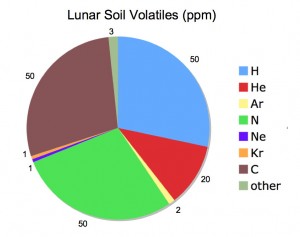Can we be “resourceful” on the Moon? (Part 1)
Discussions on forums show that there is a lot of confusion and lack of knowledge about space resources in general and lunar resources in particular

While the resources of space have the potential to revolutionize spaceflight—giving us a much wider range of activities than are now possible, including habitation of other planetary bodies—discussions on various internet forums show that there is a lot of confusion and lack of knowledge about space resources in general and lunar resources in particular. To some, the idea of harvesting and using resources from a body other than Earth has a science-fiction aura—for them, air, propellant and food manufactured for people belongs on the silver screen, not in space or on other worlds.
So, what is a “space resource?” In broad terms it is needed materials or energy derived from space itself. The value of space resources is immediately obvious; at transport and delivery costs exceeding $20,000 per pound to low Earth orbit, everything we find and use in space is one more thing we do not have to pay exorbitant costs to transport. For human spaceflight, consumables are heavy but absolutely necessary. This category includes air, water, electrical power, and rocket propellant. On a long space journey, we could save millions to billions of dollars by re-fitting consumables in space rather than dragging them all up to orbit with us from the deep gravity well of the Earth.
Unfortunately, the materials and energy we need in space are not there in the form we need them. Thus, our task is to convert what we find into what we want. There’s nothing magical about this – modern industrial chemistry is largely concerned with this very topic. All you need to convert chemical substances in one form to another one is time and energy. Fortunately, both are available in quantity in space, especially if you use automation and robotics to perform a lot of this work. Creating systems to harvest and utilize space resources has the benefit of boot-strapping a self-sustaining, spacefaring capability instead of remaining tethered to never-ending, one-off expenditures and Earth’s gravity well.
For many years we have used energy provided by the sun to generate electrical power in space but we have yet to use any material resources. The Moon is the nearest object offering usable resources. Contrary to common belief, the lunar surface contains virtually all the elements one needs to create usable products for human space faring, including air, water and rocket propellant.
It’s often said that the Moon is resource-poor. That is inaccurate; the Moon is resource different. It is depleted in volatile substances (those that have very low melting points). The most important rare resource on the Moon is hydrogen. The Moon itself has very little of this element, but the soils have a great deal of it; because the Moon has no atmosphere or global magnetic field, the stream of protons from the Sun (the solar wind) implants hydrogen onto the surface of the dust grains on the Moon. This solar wind hydrogen can be released through heating of the dust. When you have both hydrogen and oxygen, you have air, water, and rocket propellant.
The typical hydrogen concentration in most soils is 20 to 100 parts per million. This is enough quantity to extract and use, especially if much of the mining and processing work is done through robotic machines operated from Earth. Hydrogen appears to be present in higher quantities in soils that have high titanium content, which are abundant on the lunar near side (the Apollo 11 landing site has one of the highest titanium contents found on the Moon to date).
Now there are even more exciting resource prospects. The Moon has abundant hydrogen at the poles, enriched by more than a factor of three over the global average. Some of this hydrogen, present in the permanently dark and cold floors of polar craters, may be in the form of water ice. Additionally, with the spin axis of the Moon perpendicular to the plane of its orbit around the Sun, some peaks near the poles appear to be in near-permanent sunlight, permitting continuous collection and use of solar electrical power, as well as the important benefit of a near constant surface temperature.
For these reasons, recent international exploration of the Moon has focused on the poles of the Moon, where extracting and using lunar resources is easiest and where humans have the greatest potential to learn how to live off-planet and exploit space resources to create routine access in cislunar space and into the Solar System.
Next: Changing our approach to spaceflight.
/https://tf-cmsv2-smithsonianmag-media.s3.amazonaws.com/accounts/headshot/blog_headshot_spudis-300x300.jpg)
/https://tf-cmsv2-smithsonianmag-media.s3.amazonaws.com/accounts/headshot/blog_headshot_spudis-300x300.jpg)